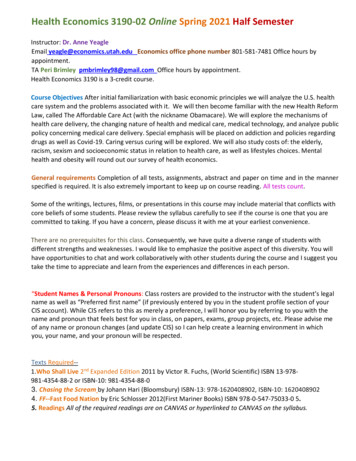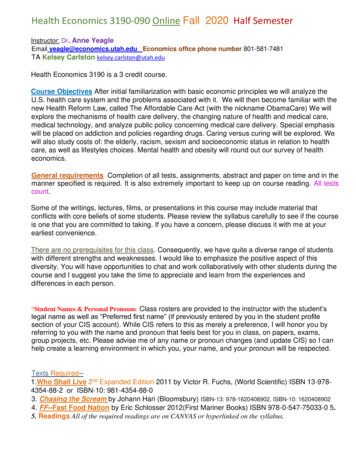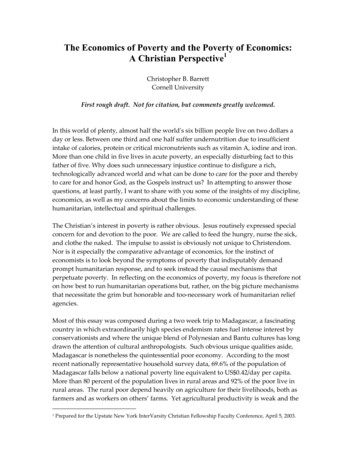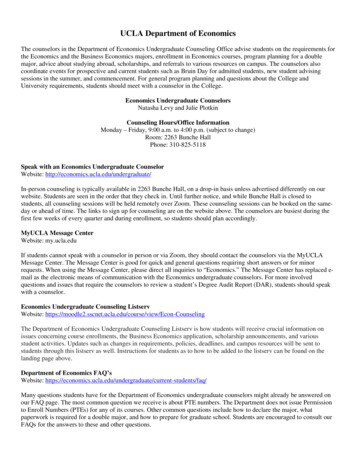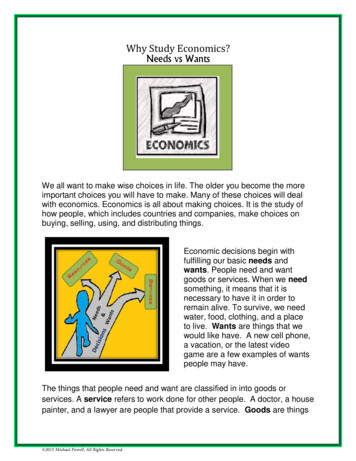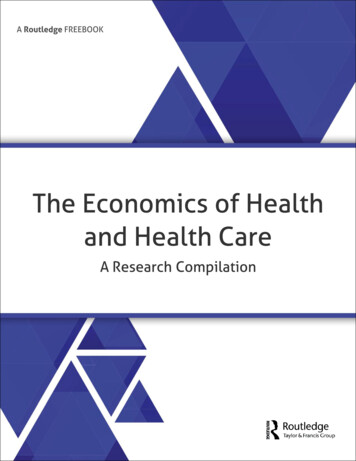
Transcription
A Rout l edge FREEBOOKThe Economics of Healthand Health CareA Research Compilation
Introduction1 - Accounting for Fairness and Efficiencyin Health Economics2 - Health, Genuine Uncertainty, andInformation3 - On the Normative Status ofEmpirically Elicited PrioritizationPreferences4 - Coronary Artery Disease5 - Kenya's Health Innovation Capacity6 - A Political Economy Perspective onthe Economic Impact of AIDS
READ THE LATEST ONTHE ECONOMICS OF HEALTHWITH THESE KEY TITLESVISIT WWW.ROUTLEDGE.COM/ ECONOMICSTO BROWSE THE FULL RANGE OF OUR ECONOMICS TITLESREQUEST AN INSPECTION COPY OF THE ECONOMICS OF HEALTH ANDHEALTH CARE HERE
IntroductionWe put together this FreeBook to complement the publication of the 8th edition of TheEconomics of Health and Health Care, the market-leading textbook covering all aspectsof health economics.The six chapters included here focus on different elements of the field of health andhealth care economics, and range from the theoretical to the more practical. Ourintention in selecting these chapters was to provide you with an overview of the workthat's been done in this subject area over the past decade, and highlight the breadthand depth of this field of study.Our hope is that you will use this FreeBook in your classroom alongside The Economicsof Health and Health Care. The variety of content included here means that there issomething for everyone, whether you are looking for case studies or additional researchthat your students can use as a jumping-off point for their own study.These six chapters have been reproduced in their entirety,and all formatting andin-text references have been preserved from the original work. This means that youmay notice some inconsistencies in things like citation format from chapter to chapter,or that you may come across a reference to previous content in the original work (andnot this FreeBook). We don't anticipate that these details will have any impact on thevalue of this collection or impede its use as a learning or reference tool.To learn more about any of the books featured in this FreeBook, please feel free to useany of the links on page 3 of this book, or go directly to the chapter page and navigateto our website from there. To request an inspection copy of The Economics of Health andHealth Care and consider the textbook for use in your course, click here.4
1#ACCOUNTING FOR FAIRNESSAND EFFICIENCY IN HEALTHECONOMICSBY JOSHUA COHEN AND PETER UBELThis chapter is excerpted fromThe Social Economics of Health CareEdited by John B. Davis 2001 Taylor & Francis Group. All rights reserved.Learn more
Chapter 1ACCOUNTING FOR FAIRNESS ANDEFFICIENCY IN HEALTH ECONOMICSJOSHUA COHEN AND PETER UBELExcerpted from The Social Economics of Health CareIntroductionThe use of economic reasoning to analyze health care is a comparatively recentdevelopment. However, the seeds for this development were sown long ago. Highlyinfluential neoclassical economists like Paul Samuelson, emulating the success ofthe natural sciences in employing calculus, derived behavioral rules frommathematically tractable first-order principles. Postwar neoclassicals wanted toreduce the ambiguity of certain economic concepts and remove value ladennessfrom economics. It was thought that by increasing the hardness of economics, theycould do both. Formulating economic theory mathematically undoubtedlyincreased hardness, which in turn made certain concepts less ambiguous.Theoretical claims that did not lend themselves to mathematical translation wereeven cast aside by some neoclassicals: '[A]ny sector of economic theory whichcannot be cast into the mold of such a [mathematical] system [of equations] mustbe regarded with suspicion as suffering from haziness' (Samuelson 1947: 9).Samuelson admitted that the degree of hardness in economics could only beconsidered 'intermediate,' but that 'when one descends [in degrees of hardness]lower. . . say to certain areas of sociology . . . [they] are almost completely withoutsubstantive content' (1947: ix).Post-war neoclassicals were often critical of the methods being used in the 'softer'social sciences. Neoclassicals attempted to impose more rigorous economicmethods on these other social sciences, a practice that became known aseconomics imperialism. The neoclassical view that economic theory studies theallocation of scarce means with alternative uses (Robbins 1932) did not precludethe study of scarce noneconomic means with alternative noneconomic uses.Perhaps the most successful example of economics imperialism is found in GaryBecker's work. In the 1960s and 1970s, Becker revolutionized the study ofsociological phenomena such as family, race, and class, using a neoclassicalapparatus of analytical tools (Becker 1976).Health economics is a relative newcomer to the economics profession. It became asubdiscipline (with its own peer-reviewed journals and professional associations)in the 1980s. Health economics fits neatly under the rubric of economicsimperialism as health economists generally analyze health care using aneoclassical model of behavior. In the process of subjecting health care toeconomic analysis, health terms are translated into economics jargon; healthbecomes a product, patients consumers, doctors health care providers, the hospital6
Chapter 1ACCOUNTING FOR FAIRNESS ANDEFFICIENCY IN HEALTH ECONOMICSJOSHUA COHEN AND PETER UBELExcerpted from The Social Economics of Health Carea product delivery system, and care managed.As the field of economics has become increasingly quantitative,it has become lesslikely for health economists to focus attention on ethical values such as fairnessthat are presumably less quantifiable. This said, the need to emphasize the ethicaldimension associated with economic decisions is perhaps more evident in healthcare than in other sectors of the economy. Certainly, the ethical issues raised bypossible tradeoffs between fairness and efficiency in health care illustrate the risksof relying too much on quantitative economic approaches, such as Paretian welfareanalysis, that ignore ethical considerations.Health economists may see themselves solely as engineers, offering technicalsolutions to technical problems. However, they are at least indirectly concernedwith ethical issues. When a health economist is asked to evaluate the kind ofhealth output to be produced? longer life expectancy, increased quality of life,fewer sick days? answers to this question presuppose a certain ethical view aboutwhat is best for society. Furthermore, when health economists deal with questionsof distribution such as To whom should Medicaid funds be allocated?' they areconcerned with fairness. Even if supposedly value-neutral Pareto distribution rulesare used in the name of improved efficiency, a certain fairness norm is implied. ThePareto definition of efficiency implies definite value judgments about fairness.This chapter describes how ethics and economics interact in the area of healthcare rationing. This section has explored the advantages and limitations of usingParetian welfare economic analysis to evaluate the fairness-efficiency implicationsof health care rationing. The second section explains how the possibility of afairness-efficiency tradeoff needs to be assessed both within the dollars domainand between the dollars and rights domains. The third section evaluates apractical case of explicit health care rationing, the Oregon health care initiative.This initiative is assessed in terms of how it has promoted fairness and efficiency.Conventional wisdom on the fairness-efficiency tradeoff'The market needs a place, and the market needs to be kept in place' (Okun 1975).Rights and dollars domains Okun (1975) distinguishes rights and dollars domainsin society. The chief distinguishing characteristics of the rights and dollarsdomains, according to Okun, are equality1 and efficiency, respectively. In the rightsdomain, political and judicial institutions provide universally distributed rights and7
Chapter 1ACCOUNTING FOR FAIRNESS ANDEFFICIENCY IN HEALTH ECONOMICSJOSHUA COHEN AND PETER UBELExcerpted from The Social Economics of Health Careprivileges that proclaim the equality of all citizens. However, in the dollars domain,society's economic institutions rely on market-determined incomes that producesubstantial disparities among citizens in material well-being. Hence, some degreeof inequality, unequal spread of wealth, is guaranteed by virtue of the competitiveaspects of the market process. There are winners and losers in the marketplacewhere motives to maximize profits and consumer utility reign. Under an ideal setof assumptions, utility- and profit-maximizing behavior lead to the most efficientoutcomes.It seems that the two domains can be further distinguished by theinexchangeability of rights for other rights, as opposed to the exchangeability ofdollars for commodities with dollar value and vice versa. Rights may not be boughtand sold, whereas dollars can (either for commodities with dollar value or for otherconvertible currencies). For example, every citizen has a right to vote, and eachcitizen's vote is counted equally. No one has to pay for this right, nor is thewealthier citizen's vote weighed more than the poor citizen's. Furthermore, no oneis supposed to sell their vote.2Policymakers can intervene in both domains. In the rights domain, policymakershelp to establish and fortify citizens' rights. In the dollars domain, they canmitigate for the possibly negative side effects of an unregulated marketdistribution of dollars.3 The unregulated market evidently promotes economicgrowth, but does this unevenly across the population.Policymakers appear to be faced with two types of tradeoffs. On the one hand,within the dollars domain, efficiency can be traded off for a more equaldistribution of dollars, or vice versa. On the other hand, efficiency can be traded offfor an enlargement of the scope of rights, or vice versa.Consider how this general discussion of the rights and dollars domains applies tohealth care as it is organized in the United States. In the United States, health careoccupies both domains. On the dollars side, health care is a major industryaccounting for more than 15 percent of the nation's Gross Domestic Product.Health care has all the attributes that we associate with big business?corporations, stockholders, mergers, bankruptcies, etc. However, a certaincircumscribed area of health care is protected from the dollars domain. This areaoccupies the rights domain, where, for instance, a number of constitutionallygrounded health care rights are universally distributed to citizens such as the rightto refuse treatment, and the right to emergency treatment.4 Additionally, a number8
Chapter 1ACCOUNTING FOR FAIRNESS ANDEFFICIENCY IN HEALTH ECONOMICSJOSHUA COHEN AND PETER UBELExcerpted from The Social Economics of Health Careof legal rights to health care are specifically targeted at certain subpopulationssuch as Veterans, the elderly, and the very poor. Programs such as Medicare andMedicaid establish inalienable legal rights to the provision of health care servicesto those who qualify for them. These programs serve in part as a buffer against thevagaries of the market, making sure that inability to pay for health care servicesdoes not prevent eligible citizens from access to health care.Equality and efficiencyEquality as a proxy for fairness appears to be the guiding principle behinddecisions made in the rights domain, whereas efficiency (mediated by utility andprofit-maximizing behavior) appears to guide the decision making process in thedollars domain. Equality in this context implies that it is our duty to treat eachother as if we are equal, disregarding certain characteristics that make us differentsuch as race, gender, and socioeconomic status. This idea hinges on the Aristotelianprinciple that 'like cases be treated like.' The principle 'treat like cases like' seemsto underlie many, if not all, notions of fairness. But, it begs the question 'Whichcharacteristics do we consider morally relevant likenesses?' The various notions offairness differ not in whether like cases should be treated like, but instead withrespect to what are considered morally relevant likenesses. For example, when wehave life saving treatments that could either save the life of someone who couldbe returned to perfect health, or the life of someone who will have a disability, areboth types of patients alike because they are human beings, and therefore deservelife saving therapy? Or, are they unlike each other in that one will have a disabilityand the other will not (see Nord et al. 1999)?It would be presumptive to suggest definitive answers to the latter questions.However, we can say that unless everyone is equal with respect to the likenessesthat we may consider to be morally relevant, which of course is not the case,providing everyone with the same amount of health care would not make muchsense.Efficiency in this context comprises a technical element: Pareto-efficient andproduction and consumption; and a social element: the Pareto principle.Technically, a number of marginal conditions must apply. The first condition is thatthe marginal rates of substitution between any pair of distributable commodities,resources, or outcomes (for example, health care outcomes) must be the same forall individuals who consume both commodities or are beneficiaries of both9
Chapter 1ACCOUNTING FOR FAIRNESS ANDEFFICIENCY IN HEALTH ECONOMICSJOSHUA COHEN AND PETER UBELExcerpted from The Social Economics of Health Careresources or outcomes. The second condition is that the quantity of eachcommodity, resource, or outcome produced conforms with consumer (orbeneficiary) preferences. That is, the marginal rate of transformation in productionmust equal the marginal rate of substitution in consumption for every pair ofcommodities, resources, or benefits. If these conditions do not hold, a shift in thepatterns of production and/or consumption is possible which would benefit somewithout injuring others. These technical conditions imply the social elementassociated with Pareto efficiency, namely, the widely cited Pareto principle whichsays that a change (for instance, a health care policy change) is desirable if itmakes some individual(s) better off without making any others worse off.It should be noted here that the Paretian form of distributive justice merelyaccounts for a preference-satisfaction view of human well-being. It is far from clearwhether such a view suffices as an adequate account of wellbeing? especially inthe context of health. The preference-satisfaction view would appear in certaininstances to assume too tight a connection between choices and preferences and,in turn, too tight a connection between preference-satisfaction and well-being.Visible acts of choice are supposed to accurately reflect preferences. But, in fact,important choices in health care, choices made by patients and health careproviders alike, may be more reflective of certain moral constraints than they are ofpreferences. As for preference-satisfaction, it may fail to improve well-being if thepreferences being satisfied are irrational, poorly cultivated,or simply based onincomplete or false information.Equality-efficiency tradeoffAs noted above, equality (as a proxy for fairness) and efficiency are presumed torelate inversely. The inverse relationship between equality and efficiency can bedepicted using the indifference curve tool. In Figure 4.1 below, following Rawls(1971: 37-39), the indifference curves (I and I') represent possible combinations ofequality and efficiency that are considered by society to be equally just.5 Societycan attach weights to equality and efficiency given its respective notions ofdistributive justice, whether these are egalitarian, Rawlsian, utilitarian, orlibertarian. The slope of an indifference curve at any particular point expresses therelative weight allotted equality and efficiency. A more vertical curve (I) givesrelatively more weight to equality, while a more horizontal curve (I'), allots moreweight to efficiency. The more important and/or the more poorly satisfied a value10
Chapter 1ACCOUNTING FOR FAIRNESS ANDEFFICIENCY IN HEALTH ECONOMICSJOSHUA COHEN AND PETER UBELExcerpted from The Social Economics of Health Caresuch as equality or efficiency is, the greater the increase in another value requiredfor compensating a loss. In this context, equality can be broadly measured byevaluating the variance in, for instance, wealth or health outcomes across thepopulation. Efficiency can be broadly measured by assessing the total productionof wealth or health outcomes divided by the inputs needed to produce them.Now imagine a three-person world, one impartial distributor and two beneficiaries,X and Y. The impartial distributor distributes health care resources necessary6 toproduce certain health outcomes. These outcomes can be measured in terms ofdecreases in morbidity and mortality? life expectancy discounted for the quality oflife expected, or quality-adjusted life-years (QALYs). Suppose that there is a line,MN, that represents the locus of possible Pareto-efficient points (see Figure 4.2below). At each point on the MN curve a Pareto-efficient allocation of healthoutcomes (for example, QALYs) exists. A Pareto-efficient allocation of healthoutcomes is one in which no individual can be made healthier? for instance, interms of QALYs? without making some other individual less healthy. In otherwords, there is no redistribution possible that makes either individual healthierwithout making the other less healthy.11
Chapter 1ACCOUNTING FOR FAIRNESS ANDEFFICIENCY IN HEALTH ECONOMICSJOSHUA COHEN AND PETER UBELExcerpted from The Social Economics of Health CareThe Pareto distribution rule appears to ignore the relative (in)justice of the statusquo. From a Paretian perspective, for instance, a distributive policy that increaseshealth outcomes of a few already healthy individuals, even if this increase is onlymarginal, while leaving many unhealthy individuals just as unhealthy, would beconsidered a Pareto improvement. 'A state can be Pareto optimal with some peoplein extreme misery and others rolling in luxury, so long as the miserable cannot bemade better off without cutting into the luxury of the rich' (Sen 1987: 32).From the Paretian perspective, the locus of points, MN in Figure 4.2, is not ranked interms of equality or fairness, but only according to efficiency. Giving M to Y isconsidered just as efficient as giving N to X, but we do not know whether it is fairerto give N to X, or M to Y. The only thing we do know is that if we give N to X, andnothing to Y, Y's well-being would stay the same, while X's would improve? aPareto improvement. Needless to say, it could be that Y has an intense need for M,while X's need for N is only slight. In this case, Y stands more to gain from gettingM than X stands to lose from not getting N. But, since the Paretian viewpointprecludes the possibility of interpersonal comparisons of need intensity, we cannotcompare X and Y's needs. This is an enormous limitation. In fact, the only thing wecan definitively say is that all points below MN are inferior distributions in terms ofPareto efficiency.If we add the 45-degree line representing a simple equal division of health12
Chapter 1ACCOUNTING FOR FAIRNESS ANDEFFICIENCY IN HEALTH ECONOMICSJOSHUA COHEN AND PETER UBELExcerpted from The Social Economics of Health Careresources, and we assume simplistically that resources and outcomes areproportionate, we can rank points on MN in terms of how much or little equalitythey denote (see Figure 4.3 below). For example, compare point C to point D. If weplace weight on an equal division of health outcomes, D would be considered a'better' distribution than C, despite the fact that they are both technically just asPareto-efficient.7Tradeoffsinevitable?Notice how in the case of the C-D comparison in Figure 4.3, the presumption thatthere is necessarily an equality-efficiency tradeoff is demonstrated to be false.Efficiency and equality do not always have to be balanced against each other. Movingfrom C to D improves equality while we remain on the same Pareto-efficientlocus.8There are in fact a number of other rules of distribution that do not have tradeoffimplications? are not zero-sum games. Positive- as well as negative-sum gamesare possible between equality and efficiency. One such rule? resourceequalization? is described in Culyer (1990). On the basis of a hypothetical case ofglobal-budget health care rationing, Culyer illustrates the tradeoff implications of13
Chapter 1ACCOUNTING FOR FAIRNESS ANDEFFICIENCY IN HEALTH ECONOMICSJOSHUA COHEN AND PETER UBELExcerpted from The Social Economics of Health Carethree different distributive rules. Culyer shows the effects the different rules haveon the degree of efficiency, measured in terms of population health outcomes perresource unit expended, and the degree of equality, measured in terms of variancein population health outcomes. The first rule Culyer considers, the radicallyegalitarian distribution rule, equalizes health outcomes across the population.Given differing individual health care needs, such a distributive rule impliesallocating the medically neediest a disproportionate share of resources. It mayeven imply allocating all resources to the medically neediest depending on theinitial dispersion of health care needs across the population. A completely evenspread of health outcomes raises the health outcome levels for some (the initiallysickest) while possibly lowering the outcomes for others (the initially healthiest) asthis rule implies actively lowering the latter's health to the lowest commondenominator. The population's overall health outcome level may drop as theinitially healthiest may stand more to lose than the neediest stand to gain. Culyerstates, therefore, that radical equality comes at a price: an inefficient allocation ofresources.Culyer next considers the utilitarian distribution rule which aims to maximizeaggregate health outcomes. This rule is maximally efficient, given Culyer'sdefinition of efficiency, as the outcomes per unit of input are maximized. However,the gain in efficiency is offset by a loss of equality; the variance in healthoutcomes across the population increases, leaving the initially sickest even sicker,while the initially healthiest either remain healthy or get healthier. Culyer statestherefore that utilitarian efficiency comes at a price; an unequal allocation of bothresources and outcomes.The third and most interesting case Culyer considers is a compromise between theutilitarian and egalitarian rules. He calls this compromise resource equalization. Thisegalitarian rule is less radically egalitarian than outcomes equalization. It isinspired by Dworkin's equality-of-resource-endowment rule (see Dworkin 1985).The point of this rule is to give everyone an equal 'minimally adequate' share ofscarce health care resources. People can do what they want with the resources attheir disposal, in line with their health-related preferences. As a result, societalhealth care resource utilization will reflect differing preference and initial healthendowment patterns among people. If people start out with equal resources, ahealth care market allocation will result in some people benefitting more, andothers less from their initial resource endowment, depending on their initial healthstatus and their preferences. Access to health care resources is spread evenly across14
Chapter 1ACCOUNTING FOR FAIRNESS ANDEFFICIENCY IN HEALTH ECONOMICSJOSHUA COHEN AND PETER UBELExcerpted from The Social Economics of Health Carethe population. But health outcomes are unevenly distributed, both becauseindividuals' needs and preferences are different to begin with, and because eachindividual's capacity to benefit from resources is different. However, theunevenness of distribution is less than it would have been in the utilitarian case.Additionally, resource equalization is more efficient than a radically egalitariandistribution. This compromise case of resource equalization does not necessarilyimply a tradeoff between equality and efficiency. Compared to initial degrees ofequality and efficiency, resource equalization may improve both.9The Oregon initiativeThe first and second sections above describe in abstract terms the relationshipbetween fairness and efficiency, against the backdrop of Paretian welfare analysis.These two sections also theoretically describe how the fairness-efficiency tradeoffplays itself out both within the dollars domain and between the dollars and rightsdomains. In this section we evaluate a practical case of explicit health carerationing, the Oregon health care initiative. This initiative is assessed in terms ofhow it has promoted fairness and efficiency both within the dollars domain andacross the dollars and rights domains. The inevitability of a fairness-efficiencytradeoff is called into question.In 1983, the President's Commission for the study of ethical problems in medicineand biomedical and behavioral research asserted health care's special statusamong 'goods' that 'society has a role in distributing as equitably as possible.'Evidently, there is something special about health care. In a way different fromother kinds of services, health care services allow us to pursue important life goalsthat could not be pursued without them (Daniels 1985). Because of health care'sspecial place in society, it is often argued that health care should not bedistributed solely according to either ability, or willingness, to pay. Given healthcare's unique status, the Commission suggested that 'all Americans should haveadequate access to health care resources,' access being defined by the Commissionas the ability each citizen has to secure necessary health care without being barredfor reasons of social status, income, ability to pay, place of residence, or otherfactors extraneous to the appropriate delivery of health care services.10 For allintents and purposes, however, the federal government has since abandonedfairness as a goal of health care policy (Caplan 1997: 148). If there is a commonpurpose to government health care policy today, it appears to be cost containment15
Chapter 1ACCOUNTING FOR FAIRNESS ANDEFFICIENCY IN HEALTH ECONOMICSJOSHUA COHEN AND PETER UBELExcerpted from The Social Economics of Health Carewhich, if viewed charitably, is supposed to be synonomous with efficiency. Thegrowth in health expenditures has been contained over the last 8 years followingincreased enrollment in managed care. Managed care has managed to controlcosts somewhat by way of capitation, or prospective payments of lump sums tohealth care providers per patient, rather than retrospective payment per medicalintervention as under fee-for-service.The exponential rise in health care costs over the last three decades, from 7percent of GDP in 1968 to over 15 percent of GDP in 1998, raises the specter of ahealth care system out of cost control. However, this cost problem should not maskthe problems related to lack of fairness in the health care system. Despite moremoney being pumped into health care during the last three decades, the numbersof uninsured (more than 44 million in 1998, or 17 percent of the Americanpopulation) and underinsured have risen dramatically while population-widehealth-outcome measures have not improved significantly during this timeperiod.11Rising costs related to the Medicaid program,together with federal Medicaidbudget cuts in the 1980s, led many state governments to arbitrarily limit Medicaideligibility by lowering the income threshold level by as much as 35 percent. On theface of it, this seems to be grossly arbitrary. Limiting eligibility on income groundsrather than medical necessity does not even seem rational, given that one of theoriginal goals of the Medicaid program was to protect the poor from being infinancial dire straits due to the costs of health care. In fact, this way of rationingseems to institutionalize rationing according to ability to pay rather than medicalnecessity.In 1989, John Kitzhaber, a physician, community leader, and then state senatechairman in Oregon,12 launched an initiative designed to reduce the arbitrarinessassociated with Medicaid rationing. Kitzhaber was fundamentally opposed torationing according to ability to pay. Instead, he wanted to construct a 'rational,'publicly accountable rationing system. Kitzhaber gathered the support of manylocal politicians, community activists, physicians, patient representatives, and stateMedicaid officials to push the initiative through the state legislature. Theinitiative's main purpose was to improve the poor's access to Medicaid by addingas many uninsured people to the Medicaid rolls as possible. All residents withincomes below the federal poverty level would become eligible for Medicaid, notjust the very poor. As a result, the option of arbitrarily rationing people out of the16
Chapter 1ACCOUNTING FOR FAIRNESS ANDEFFICIENCY IN HEALTH ECONOMICSJOSHUA COHEN AND PETER UBELExcerpted from The Social Economics of Health Carehealth care system no longer existed. Rather than rationing by excluding people,the initiative proposed rationing by way of exclusion of health care services.The Oregon initiative constitutes an effort to develop an integrated social policyapproach, not strictly a health care policy approach. Dollars spent on health careimply an opportunity cost in terms of forgone alternative spending outlets.Resource allocations for health care are balanced with allocations in related areaswhich also affect health, such as education. The Oregon initiative proposes asystem of resource allocation that recognizes scarcity and opportunity cost, andhence the need to allocate funds and resources among many
To learn more about any of the books featured in this FreeBook, please feel free to use any of the links on page 3 of this book, or go directly to the chapter page and navigate to our website from there. To request an inspection copy of The Economics of Health and Health Care and co



